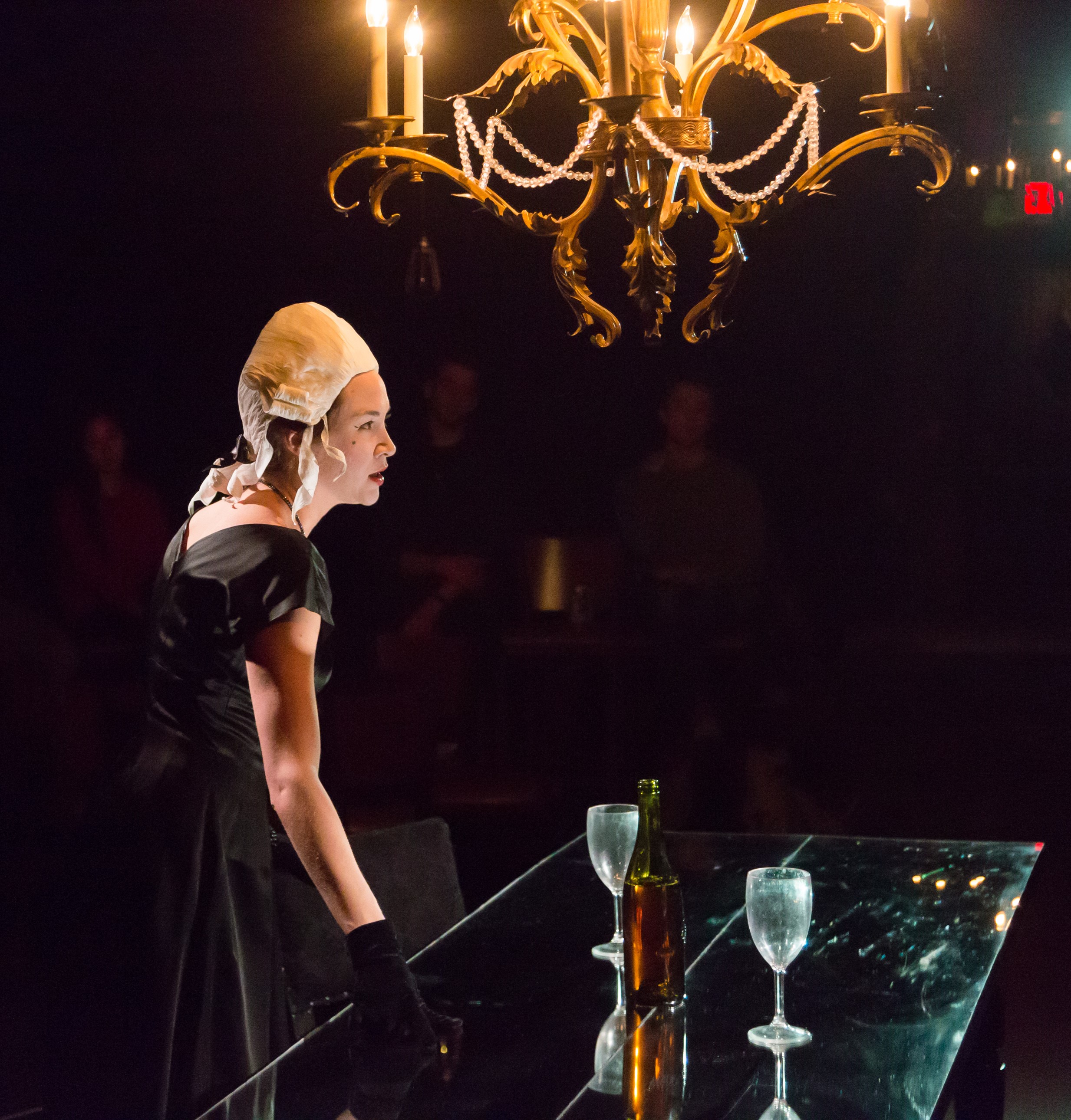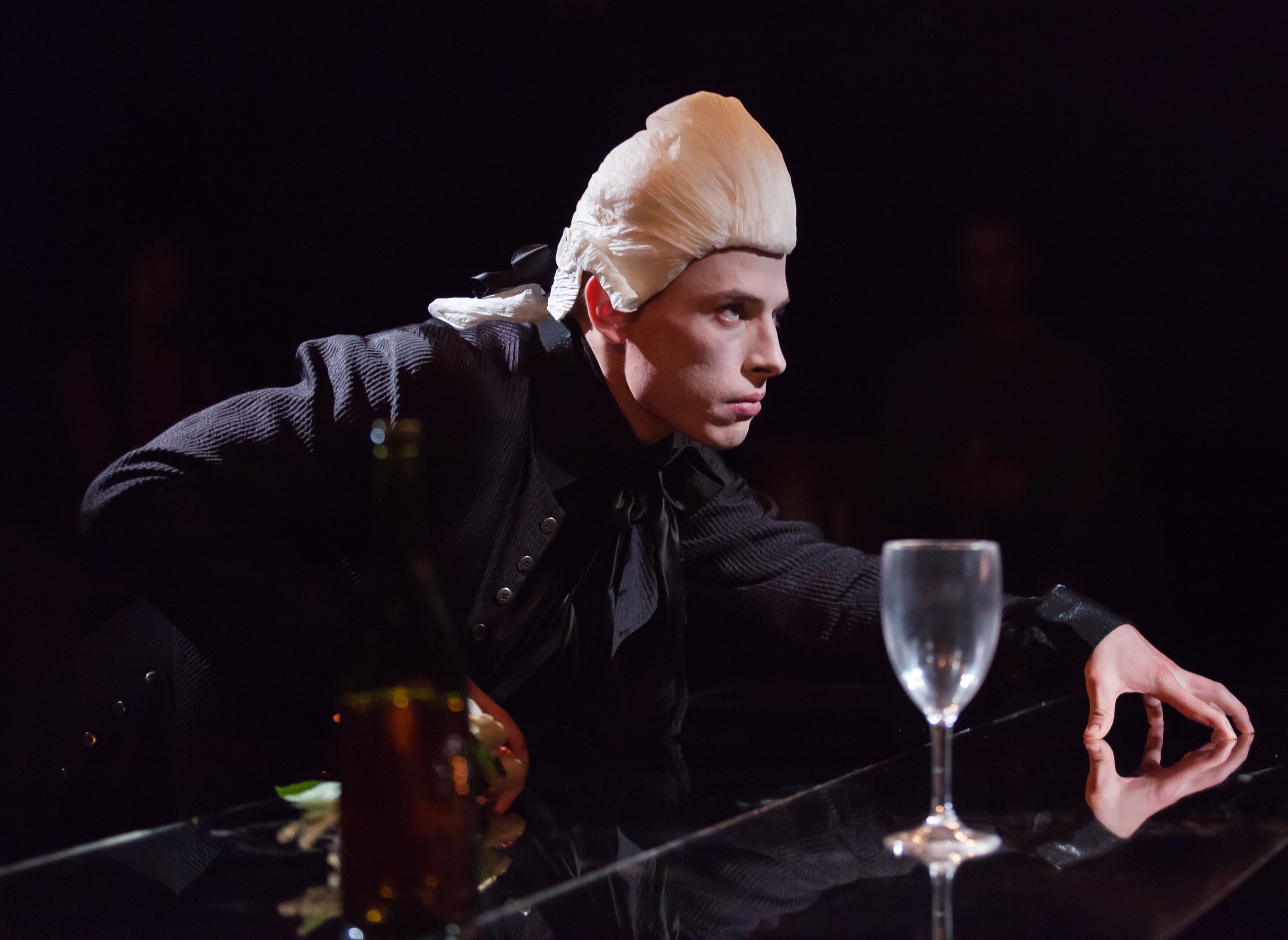Review of Quartet at the Yale Cabaret
Heiner Müller’s Quartet, an adaptation of Laclos’s Les liaisons dangereuses, as staged at the Yale Cabaret, directed by David E. Bruin using Doug Langworthy’s translation, makes fancy-dress role play of the nefarious seductions indulged in by the Marquise de Merteuil and her favorite play-fellow the Vicomte de Valmont. Famously paired libertines who engage in sexual relations with others as a sort of blood sport—comparing conquests and challenging one another with tests of their mettle—Merteuil and Valmont pride themselves on being able to inspire and command passion without ever really surrendering their emotions. Cold-blooded sex machines, they are sophisticated epitomes of the “player” ethic.
With a hanging chandelier, low-wattage lights, and dark walls, the Cab has been transformed into a suitable “den of iniquity” as we gather around a handsome dining table of dark wood, a single chair on each side, to witness the elegant pas de deux of this entrancing duo. As the mercurial Merteuil, Sydney Lemmon enters first, delivering the lines of a missive to Valmont (Laclos’ original is an epistolary novel), chiding him, enflaming him, belittling him, all from behind a forbidding hauteur. At last Edmund Donovan enters and at once the terms of the relation change. Valmont’s characteristic attitude is an almost unreadable sang-froid, though full of fulsome sallies that keep both Merteuil and the audience guessing about his true nature.
Bandied about in their exchanges are possible apt conquests to come. Merteuil would have Valmont seduce her virginal niece; Valmont prefers the game of inspiring passion in a staid married woman, Mme de Tourvel. There’s quite a flurry of wits in describing which sample of “the flesh” should be more appetizing to Valmont’s tastes.
The height of the play occurs in a scene in which Merteuil, in male drag as Valmont, attempts to seduce Valmont, in drag as Mme de Tourvel. In a sense, we’re simply watching actors trade roles as Lemmon plays Valmont—with remarkable flourishes—and Donovan plays Mme de Tourvel, with even more hauteur than Lemmon’s Merteuil commands. But in a more telling sense we’re watching Merteuil as Valmont and Valmont as Tourvel. The exchanges are fraught with a delicious double-vision: Merteuil’s contempt for Valmont—or, indeed, of the easy lust of men—adds to Lemmon’s seductiveness as Valmont. Meanwhile, Donovan’s rendering of Valmont’s interpretation of femininity exposes, to some degree, what leads the rake on the chase: a feminine sense of completeness quite indifferent to male desire. Arch and verbally acrobatic, the scene also plays as a true seduction, albeit with self-conscious staginess, such as Valmont’s tearful gushing and Tourval’s defiant surrender.
Songs—on the soundtrack, as it were—often add considerably to the stakes. The use of the Velvet Underground’s haunting “Candy Says” after this scene helps to underline the more tragic aspects of such erotic wrangling (“Candy says I’ve come to hate my body and all that it requires in this life”). In the pause after the seduction of Tourvel, we’re left to reflect on how denial of the body adds a deeper meaning when a seduction succeeds. The victory is on the side of the flesh itself, not simply the cunning of a seducer. Inevitably, there must come a reminder that even the most dedicated debaucher must surrender his body, and all lovers of the flesh will be at some point thwarted. At the hour of death.
The final tableau of the play, with Merteuil clinging to the lifeless Valmont, lets the pendulum of froideur swing to the masculine side as Valmont, dead, is beyond vanity and desire. On the way to that dramatic conclusion, the far more straight-forward—and less satisfying on every score—seduction of the niece/Merteuil (Lemmon) by Valmont (Donovan) forces both Merteuil and Valmont to play against type. Though we’re free to imagine, if we like, that somewhere in the cat-and-mouse exchanges resides the heart of cruelty, I miss in Müller’s version the affront to Merteuil of Valmont’s actual love for Tourvel, which, in the original, spoils the bet by which Valmont might possess Merteuil.
Still, the “drag scene” seduction adds layers of suggestion, lacking when everyone keeps to the predetermined gender roles. Bruin and his cast do a commendable job of minimizing camp, letting these two supreme sexual predators strut their stuff and flaunt their feathers—the costumes by Fabian Aguilar maintain a flair of minimal flamboyance: dark, period tailoring spiced with white wigs.
It’s been awhile since the Cab has offered a play with such a literate, dialogue-dense script. Kudos to Bruin for his grasp of the play and to Lemmon and Donovan, first-year actors in the Yale School of Drama, for their enactment of such riveting turns.
Quartet
Written by Heiner Müller
Translated by Doug Langworthy
Directed by David E. Bruin
Adapted from the novel Dangerous Liaisons
Set Designer: Mariana Sanchez; Costume Designer: Fabian Aguilar; Lighting Designer: Caitlin Smith Rapoport; Sound Designer: Kate Marvin; Technical Director: Kate Newman; Dramaturg: Paul Cooper; Stage Manager: Kelly Montgomery; Producer: Anh Le
Yale Cabaret, January 22-24, 2015
The Cabaret is dark next week before returning February 5th (see our preview here). The remaining six shows will be previewed soon. For my review of 50:13, last week's opener of the second half of the season, go here.



